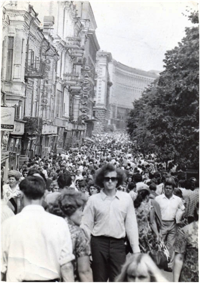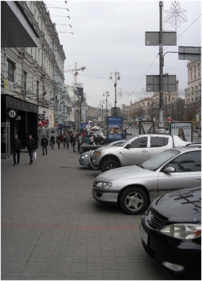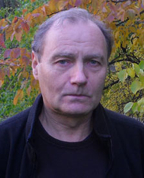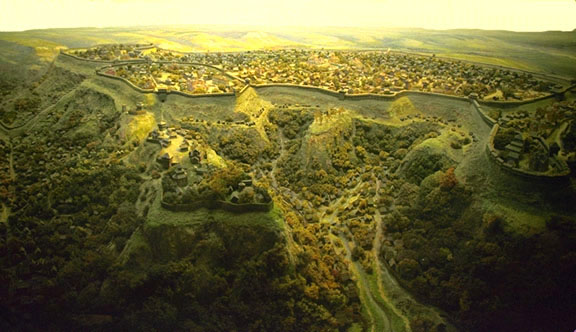 Loitering the central streets of my native town, Kiev, where I had lived for 63 years, I involuntarily examine the passers-by. Gosh, how changed the appearance of citizens! I notice some subspecies that I never met before--such as a subspecies of managers--short-haired young people in white shirts, a subspecies of guards--stern-looking lads with bull’s napes, a subspecies of builders--lads from other towns. The old age people are rarely seen on the streets. I peer at the faces, hoping to recognize familiar ones. But no, no way, they are all long gone. The species, the environment have changed irrevocably. Sad, but true.
Loitering the central streets of my native town, Kiev, where I had lived for 63 years, I involuntarily examine the passers-by. Gosh, how changed the appearance of citizens! I notice some subspecies that I never met before--such as a subspecies of managers--short-haired young people in white shirts, a subspecies of guards--stern-looking lads with bull’s napes, a subspecies of builders--lads from other towns. The old age people are rarely seen on the streets. I peer at the faces, hoping to recognize familiar ones. But no, no way, they are all long gone. The species, the environment have changed irrevocably. Sad, but true.
Behold the unnatural succession of the main street of Kiev:


In ecology, there is the concept of "succession," an important term which explains serial mutability of a species and its habitat. William R. Catton, Jr., in his classic book Overshoot, shows how this principle works in the human environment [1]. To understand the succession in human society, it is useful to first consider nature's succession.
Catton gives the following definition: "[Natural] succession is--“an orderly and directional process of community change resulting from modification of the habitat by the community and culminating in maximally stable relative to the characteristics of the site” [1]. That is, the most sustainable type of an ecosystem is wild nature. (Chernobyl is a “good” example).
In the course of history, human beings had learned to block natural succession primarily through agriculture, which assisted in population growth, from millions to billions. Catton writes, “A farm (no less than a garden or a town) is a contrived ecosystem. It is a greatly simplified plant (and animal) community. In successional terms, it is thus a very early seral stage, and is therefore inherently unstable. Abandoned, a farm will undergo natural succession toward a most unfarmlike climax. A kind of wilderness.” [1] Thus, agriculture is a constant struggle against succession.
This struggle comprises the takeover of territories and ruthless extermination of “useless” plants and animals. Today, the survival of millions depends on the ongoing attempt to boost human carrying capacity at the cost of remaining resources, with greatly enlarged but precarious human carrying capacity. Although a climax community, or wilderness, has more inherent stability than a farm, it won’t feed as many human beings because more of its total net production is consumed by other species.
What catered most to raise the human carrying capacity so far? Fossil fuels extraction. But, as Catton (and many others) has shown, this process is temporary and ends with the loss of resources.
In the process of modern, artificial living, the organisms change their environment. The habitat gradually becomes less and less comfortable for an indigenous species. In the human case, the life tempo and stress increase. The old and less fit can’t adapt to new conditions, and must leave or die sooner than they might. They are replaced with new species, or subspecies, which are more adaptable to the altered environment and new way of life.
The direct succession can also happen due to invaders that force out aboriginals. I remember how I once got lost in London searching for some particular street, asking the way. All the time I ran into Arabs or Hindus that shook their heads and answered unintelligibly.
Coming back to my "native" town, where I have spent all of my life, I understand that it has morphed into something quite unrecognizable. The alteration of population structure due to the influx of newcomers and departure of native residents (many emigrated after the collapse of the Soviet Union), created a much transformed environment. Not only physical, but cultural as well. That is, the cultural succession does not limit itself to altered street profiles, number of cars, or the scale of construction. Can we apply the notion of succession to culture? I think, yes. Culture also needs “ecological stability.” One can assume that similar to wild nature, culture must have minimal but permanent carrying capacity.
Let us remind ourselves of the definition of carrying capacity. According to Catton, it is “the maximum population of a given species which a particular habitat can support indefinitely (under specified technology and organization, in the case of human species) " [1].
How can we describe the "cultural carrying capacity" then? First, it is the sufficiency of renewable resources to satisfy vital and aesthetic needs. We can’t count on the idea that in the overpopulated world everyone will be satisfied to the fullest (Hardin, [2]). Second, the life tempo should not be hectic, so that every new generation has enough time to get acquainted with the legacy of the past. Third, a certain freedom of expression and creativity is needed (this can be reached only if the first condition is met).
On the contrary, if the cultural succession becomes too fast (for example, in the aftermath of revolutions), the continuity of time is broken and people are not being able in due course to master the legacy of the past and calmly transform it into new forms. Similar processes would take place when wild nature is being exterminated and replaced with monocultures: the culture degenerates, becomes poor, mediocre and is taken over by "the masses." At the same time, the population of culturally enriched people falls, and is replaced by culturally limited or struggling people.
Is such an environment stable? Obviously not, since the increased density of culturally limited people is susceptible to aggression and internal conflicts. The Darwinian laws of survival and adaptive change are entering into force. Eventually, this could lead to self-degeneration, wars and fall-off of population. Therefore, the only hope is that natural succession will renew human culture without many atrocities.
How one can assist natural succession? First, do not oppose nature, and act accordingly for a stable natural environment. This will mean getting rid of human hubris and arrogance. Second, we must understand that the civilization of growth destroys the basics of life and its wondrous matrix. Fortunately, a host of countercurrents are emerging: in economy, degrowth; in agriculture, permaculture; in society, a slower simple life; in philosophy, deep ecology, and, in the environmental movement, "ecotage," i.e., the defense of nature and of the commons. Revived are the ancient principles of wu-wei (Taoist "non-doing," or "without effort") and the teachings of Tolstoy (non-action). These help nature to speed up the rusting of civilization and a succession toward harmonious and stable co-existence. Wouldn’t it be tempting to imagine the next stage of natural succession looking like the medieval Kiev in a necklace of green hills?
Under my window, between the road and the sea-cliff, bitter wild grass
Stands narrowed between the people and the storm.
The ocean winter after winter gnaws at its earth, the wheels and the feet
Summer after summer encroach and destroy.
Stubborn green life, for the cliff-eater I cannot comfort you, ignorant which Color,
Gray-blue or pale-green, will please the stars;
But laugh at the other, your seed shall enjoy wonderful vengeances and suck
The arteries and walk in triumph on the faces.- Robinson Jeffers, from The Broken Balance
________________________

[1] William R. Catton, Jr. Overshoot: The Ecological Basis of Revolutionary Change, University of Illinois Press, 1982
[2] Garret Hardin. Cultural Carrying Capacity, 1986
garretthardinsociety.org
* * * * *
Victor Ivanovich Postnikov (b.1949, in St-Petersburg, Russia) is a former scientist, now an eco-poet, translator, and essayist. He lives in Kiev, Ukraine. He has edited and translated deep green philosophers and poets, including Culture Change essays. He is a member of the international left biocentric group and is a critic of technoscience. His websites: victorpostnikov.wordpress.com and stihi.ru/avtor/transpoetry Email: vpostnikov "at" yahoo.com
His previous articles in Culture Change were Economy of Poetics – A Sketch (Feb. 2011) and Ukraine society: a disaster like Chernobyl (2003?)


